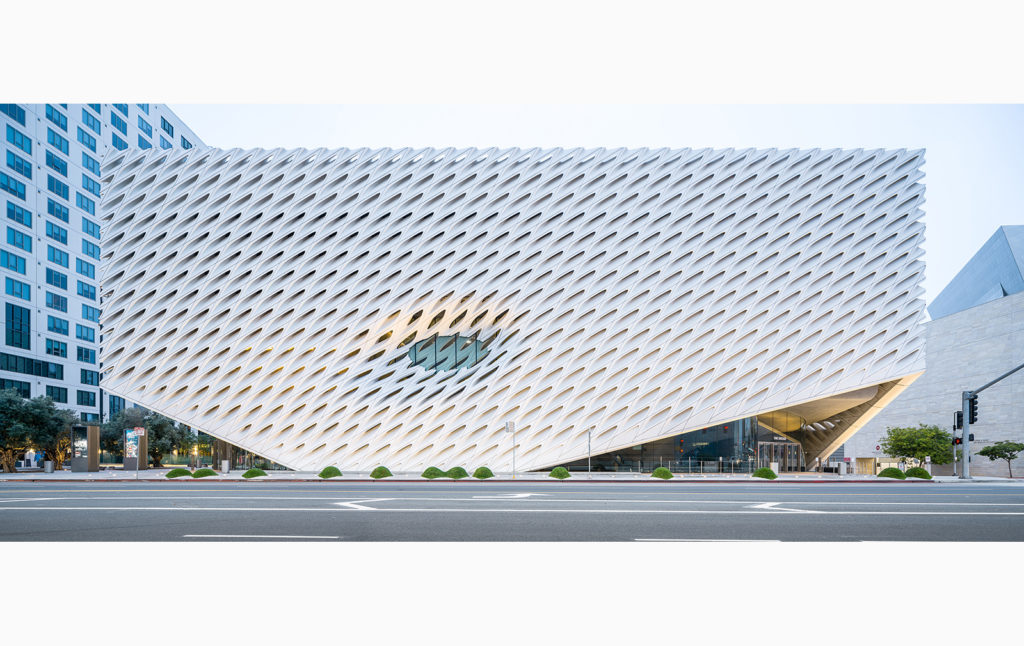City Map publisher Blue Crow has jetted to Los Angeles for its latest architectural guide, tracking down the Californian city’s concrete masterpieces.
Driven by aerospace innovation and technological experimentation, and fuelled by the ready availability of the robust material, the City of Angels saw a boom in concrete architecture during the 20th century. Architects in this mobile metropolis have embraced the material, using it in a sculptural way to produce striking forms in a wide range of styles.
Here are eight of the best modernist, brutalist and contemporary concrete structures in Los Angeles’s sprawling urbanscape.

Cinerama Dome
This 1963 Sunset Boulevard building was designed by Welton Becket & Associates for widescreen Cinerama films and is one of only a few surviving in-tact cinemas of its type. The structure’s concrete geodesic dome appears to float above the ground, while its interior retains its original curved screen.
Photography: Jason Woods © Blue Crow Media

Sheats-Goldstein House
Perching on the side of a canyon overlooking Los Angeles, this John Lautner-designed house featured in the 1963 James Bond film, Diamonds Are Forever. It is the epitome of 1960s futuristic glamour thanks to its triangular coffered ceiling. Indoor spaces flow out to the gardens, filled with an abundance of tropical plants.
Photography: Jason Woods © Blue Crow Media

First United Methodist Church of Glendale
With its repetition of triangular peaks formed from its thin-shell concrete roof, the exterior of this 1961 Flewelling & Moody-designed church has neo-gothic vibes. Inside it has the height of a cathedral and a nave filled with a kaleidoscope of bright colours from its 45-ft stained-glass windows. A concrete tripod topped with a cross stands in the churchyard.
Photography: Jason Woods © Blue Crow Media

St Basil Catholic Church
This fortress-like structure is made up of 12 angular concrete towers separated by seams of stained glass and metal mesh, which bring in streams of coloured light into the church’s interior. With an exterior devoid of decoration, the 1969 A C Martin & Associates-designed structure harks back to monasteries and churches of the medieval era.
Photography: Jason Woods © Blue Crow Media

Liberty Savings and Loan Building (now Chase)
With its unadorned concrete exterior and shaped forms, this building by Kurt Meyer and Associates is regarded as an icon of Brutalist architecture. Despite its height and solid look, there is a lightness to the structure, created by the glass walls on the bottom two floors. This is amplified by narrow, tapered vertical columns which support the horizontal bands and its flared parapet.
Photography: Jason Woods © Blue Crow Media

California State University Dominguez Hills University Theatre
Stoic, imposing and uncompromising, this Dan Dworsky-designed building built in the 1970s is an amalgamation of staggered, multifaceted forms with recessed shapes forming balconies and entrances. Its window-less exterior adds to its austere look. Glazing in the ceilings draws soft indirect light into internal walkways below.
Photography: Jason Woods © Blue Crow Media

California State University Dominguez Hills Leo F Cain Library
The standout feature of this 1972 A Quincy Jones-designed building is its top floor, which looks like corrugated cardboard. Featuring exposed waffle ceiling and louvred fins along its windows, it overhangs the lower floor around most of the building, providing shelter from the elements.
Photography: Jason Woods © Blue Crow Media

The Broad
A 2015-built contemporary art museum, designed by Diller Scofidio + Renfro with Gensler, The Broad is encased in a concrete box which houses an expansive, column-free sculptural interior. The cheese grater-style building is enveloped by a ‘veil’ – four concrete walls perforated with angular holes which filter in natural light.
Photography: Jason Woods © Blue Crow Media
The Concrete Los Angeles Map is out now
Read next: 10 music videos that show the changing face of LA through the decades

















